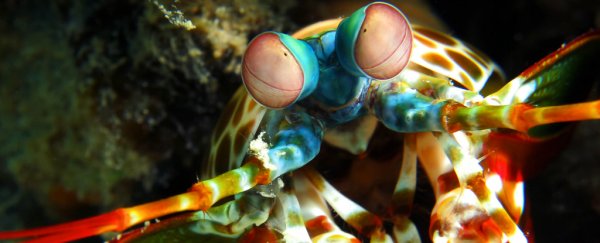Mantis shrimp are pretty much the superheroes of the crustacean world. Not only can they deliver a crazy powerful punch with their front claws, but their incredible eyes can actually see cancer, even before symptoms appear.
Now researchers are trying to build cameras that can replicate that incredible ability, so we can not only detect cancers earlier, but also operate on tumours and locate them throughout the body more accurately.
Mantis shrimp are those colourful, googly-eyed crustaceans that you've probably seen on the National Geographic channel destroying crabs with their front claws. Interestingly, they're not actually a mantis or a shrimp, but a close relative or crabs and lobsters.
The shrimps belong to the order Stomatopoda, and the majority of them live in the tropical and subtropical waters of the Indian and Pacific Oceans, all the way from eastern Africa to Hawaii.
Mantis shrimps have always been fascinating to researchers because of their powerful punching ability, but scientists realised that in order to deliver such accurate blows to their prey, they must also have incredible eyesight.
Back in 2014, a team of Australian researchers realised just how incredible that eyesight was, showing that mantis shrimps are actually able to see cancer.
This is because, like other arthropods, they have compound eyes, which are made up of thousands of light-trapping receptors called ommatidia - just like the eye of a fly.
What's extra unique about the mantis shrimp eye though is that it can also perceive something that is invisible to us humans - the polarisation of light.
"Sunlight is messy - a jumble of wavelengths moving in all directions at once," explains Elliott Kennerson over at NPR.
"But some surfaces - say, the scale of a fish, or a pair of polarised sunglasses - have a way of changing the light they reflect or transmit, organising it so it moves in a single plane."
While our human eyes can't really tell when this is happening - we can't perceive the difference between polarised and non-polarised light - the eyes of the mantis shrimps can distinguish between the two.
That's important, because researchers have shown that fast-growing, disorganised cancer cells actually reflect polarised light differently from healthy tissue.
It's a small difference that's invisible to us, but one that a mantis shrimp could easily distinguish.
"Humans can't see this, but a mantis shrimp could walk up to it and hit it," said Justin Marshall from the University of Queensland back in 2014.
Researchers have since discovered that this difference in polarised light reflection actually appears in early cancer, before other symptoms arise.
Teams around the world are now working on building cameras that can do the same thing, based on the compound eyes of mantis shrimps and other arthropods, such as butterflies.
"Looking at nature can help us design better and more sensitive imaging techniques," Viktor Gruev, who leads a team at the University of Illinois at Urbana-Champaign told NPR.
His team has designed cameras that can not only see polarisation patterns on the surfaces of human and animal tissue, but they're also small enough to be used for endoscopes and colonoscopies.
In one of their studies so far, Gruev and his team used the cameras in mice to look for signs of colon cancer. Traditional colonoscopy cameras - which are basically put up patients' butts to get a closer look at their large intestine - send back black-and-white images so doctors can look for any abnormal shapes, such as polyps.
But it turns out that not all cancers are lumpy - sometimes they're flat and look just like the surrounding tissue, and colonoscopies can miss them.
So Gruev's new mantis shrimp-inspired camera takes these polarisation patterns and converts them into colour images in real time, showing doctors exactly where the healthy tissue ends and the diseased tissue begins.
Interestingly, different types of cancer cells seem to all have different polarisation signatures, Gruev told Kennerson, while healthy tissue remains consistent.
"The polarisation structure makes the cancer apparent," said Gruev, who calls the technology a cancer 'moonshot'. "Right now, we are still detecting cancer way too late in the game."
Not only could this lead to earlier and more accurate diagnosis, but it could also help surgeons remove tumours more precisely, leading to better recovery.
Clinical trials using the cameras to remove tumours from patients with breast cancer are now underway.
Gruev's work has been published in The International Society for Optics and Photonics (SPIE) Proceedings, and was also presented in June this year at the Optical Society of America conference in California.
